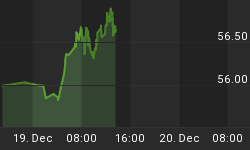For the most part, the value of the dollar is given cursory attention by the financial media. Typically, its movements are assigned an importance on par with much less determinative metrics such as natural gas futures and construction permits. It's only when major milestones are reached that anyone really takes notice of the dollar. We are living through one of those times.
The great dollar rally of 2008-2009 has come full circle. When the financial crisis exploded in its full ugliness in mid-2008, the dollar, which had steadily declined over the previous four to five years, put in a rally for the record books. By March 2009, as investors across the world sought safety from the financial storm, the index had surged more than 25%. Since then, the dollar has steadily declined to the point where nearly all those gains have vanished. In short, the panic rally has given way to the long term trend.
So, as the dollar index makes fresh 52-week lows on a nearly daily basis, discussion on the greenback is heating up. And while real insight on the topic is hard to find, the debate centers on the battle between two conventional opinions - both of which are wrong.
The first camp, which is generally supportive of government intervention in the economy, argues that dollar's decline is a positive for both the economy and the stock market. The second camp, which tends to fall on the more conservative end of the political spectrum, views the dollar's decline as a problem but feels that tough talk and slightly higher interest rates are all that is needed to restore 'King Dollar' to its throne.
First of all, a weak dollar is no better for Americans than a lower paying job is for a worker. And although I would prefer that the dollar remain strong, I know that currency values are a function of supply and demand, not wishful thinking. The past years of reckless monetary and fiscal policy have created conditions that must push the dollar down. Vastly expanded debt levels and monetary expansion have created a greater supply of dollars, while poor investment performance and diminished industrial capacity have lessened the demand for dollars.
The regrettable truth is that while the weak dollar will help rebalance the global economy, it is not a panacea for the U.S. The fall is no more worthy of celebration than a student celebrating falling grades on his report card. If the dollar does not recover eventually, Americans will suffer diminished living standards. To avoid this we must make difficult reforms now. If we continue our current policies, we run the risk of a complete dollar collapse. Far from helping to solve our problems, this would be a true nightmare scenario.
On the other side of the argument, those who correctly equate a weaker dollar with a weaker America mistakenly believe that mere posturing by officials or trivial rate hikes would be sufficient to restore the dollar's lost vitality. We are long past that point. The best we can do now is to accept the penalty of a weaker dollar as punishment for our prior failures, and start building for the future.
To save our currency, the Fed must get very aggressive with interest rate hikes and reign in the supply of dollars that have flooded the world over the past few years. The federal government must also do its part by cutting spending, which means no more stimulus and no more bailouts. Undoubtedly, these actions will have unpleasant economic and political consequences. A student who studies harder may have to miss a party or two. A simple analogy, but unfortunately it is that simple.
Even in the unlikely event that our political leaders take these courageous steps, the near-term trajectory of the dollar may still be uncertain. A dollar rally that results from higher interest rates and a narrowing federal deficit may soon fade as the recessionary forces that such moves would unleash act to weaken the dollar once again. But at least we would be building a foundation upon which the dollar could eventually find some footing.
With a restructured economy, higher savings, more capital investment, lower government deficits, and higher interest rates, the United States would once again attract international investment. Funds would flow here not out of fear, as they did last year, but out of confidence. The dollar's strength would not rest on the willingness of foreign governments to buy our debt, but the willingness of foreign consumers to buy our products.
Only then could King Dollar regain its throne.
For a more in-depth analysis of our financial problems and the inherent dangers they pose for the U.S. economy and U.S. dollar, read Peter Schiff's 2008 bestseller "The Little Book of Bull Moves in Bear Markets" and his newest release "Crash Proof 2.0: How to Profit from the Economic Collapse." Click here to learn more.
More importantly, don't let the great deals pass you by. Get an inside view of Peter's playbook with his new Special Report, "Peter Schiff's Five Favorite Investment Choices for the Next Five Years." Click here to dowload the report for free. You can find more free services for global investors, and learn about the Euro Pacific advantage, at www.europac.net.















